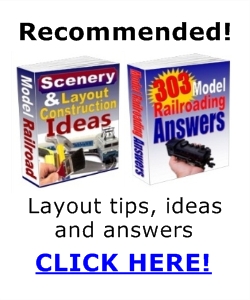How Model Railroad Structures and Model Railway
Buildings Can Add Greatly To Model Train Scenery
Creating realistic model train scenery is the part
that pulls a model railroad layout together and brings it to life. Adding weathered model
railway buildings and impressive structures like trestle bridges and flour mills all add to the
visual interest and reality of the scene.
Simple model train scenery details can make a big
difference and improve the enjoyment for everyone. Many visitors to your railroad will spend a
lot of time watching the trains operate. They may not immediately notice the fine details on the
model railway buildings and model railroad structures… but they will the longer they
watch.
Your visitors will get to notice the little things
that add to the overall model train
scenery effect. Spectators will get see the vegetation that grows alongside the track
and notice the signs on the model railway buildings and the weathering techniques used on the
trains.
Watch their excitement and interest grow as they spot
new things about the layout. Those little details you added will get noticed.
|
Model railroad structures like tunnels and bridges
will add interest to any model train layout. You’ll need a railway station too. Add
some operating signals at the railway crossings. Use either a set of crossing
flashers or a flasher and drop-arm combo. Kids (and adults too) will be mesmerized
by these 'lights and action' accessories.
Other model train scenery ideas like an operating
grain elevator, a water tower, maybe some coal loaders, or a control tower will
help complete a scene. The key is to be creative, but specific, when making model
train scenery.
|
 |
Make sure any vehicles and railway crossings are from the right era.
One idea is black washing the grilles and hubcaps to add depth and realism to a street scene. By
using a small paint brush you can also paint parking and tail lights, and door handles if needed.
Then consider disassembling each vehicle and installing a driver and passenger (s). Nothing looks
more fake on a model train layout than a vehicle appearing to be driven by a invisible
ghost.
You can purchase miniature figures for
hobby stores and railway suppliers. They come in male, female and child variations all molded in
'flesh' color. The arms are usually attached by gluing them. The figures can then be
painted.
Sometimes, there won’t be enough room
to fit the figures between the steering wheel and a seat. It sounds a bit nasty, but you simply
cut the legs off (ooch!) with pliers to make the figures fit. Use flat model paint (rather than
glossy paint) to paint on clothing and make the hair look realistic.
When buying adhesives for joining
model train scenery, there are several choices in hardware stores and hobby shops. They are not
all suitable for the same job.
When building model train scenery try
using an acrylic matt medium or white glue as these modeling adhesives will be water soluble.
Note – contact cement will be more suitable for some applications.
If you are going to use white wood
glue, you may want to dilute it with water using 2 parts glue to 1 part water, or a 1 to 1
ratio, depending on the application required. Try adding a few drops of liquid dish washing
detergent to help break up the surface tension of the water. Another idea is to add a small dab
of latex paint to tint the glue and disguise any bare spots.
Always keep model train scenery,
model railway
buildings, people and model
railroad structures to the right scale relative to the trains.
|

